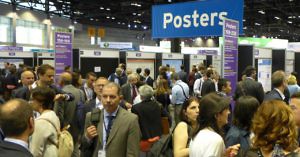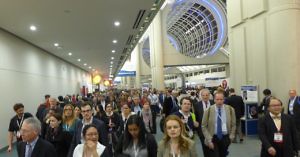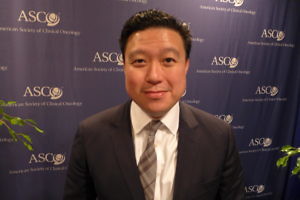We’ve come a long way over the last two years in the oncology market, with several novel approaches approved, numerous major phase 3 trials evolving and a huge turnaround for many companies in terms of early pipeline activity.

The melée at the ASCO 2016 Poster Hall
Unfortunately, this also means that the tendency of lemming activity also increases in the rush to copy everyone else and not be left behind. Just a couple of years ago, some industry friends grumbled that there were over 20 checkpoint inhibitors chasing them in development; they may be surprised to know that now there are nearly 70! This is both unprecedented and unsustainable, and yet it’s also a function of the perceived success these agents have had on the cancer R&D landscape to date. Everyone wants one for fear of being left behind… except that many are indeed way behind already.
You can imagine the tall guy on the left of the picture looking at his watch and wondering, “Ah so many new posters, so little time!”
Meanwhile, as the rate of approved cancer therapies increases, so does the inexorable march in terms of hyper-aggressive basket pricing. I would argue that at some point, it no longer acceptable or even conscionable to change a premium or even market rate for drugs that give an incremental improvement of a mere 2 months of extra life.
Equally, one thing that many industry observers and the media love to do, and wrongly in my view, is to compare the individual drug prices on an annualized basis. This is silly for several reasons:
- So far, not all patients are treated for a full year
- If patients are treated until progression and that happens early, then therapy is stopped
- What people should be looking at is the average treatment cost based on the length of therapy – some people will receive a few months and some much more than that
- What’s the true cost of a cure or remission to a patient and their family?
- How do we quantify the impact of the long lasting durable remissions?
These questions will become increasingly important as we see a more aggregated therapy approach emerge over the next few years.
By this, I mean that we are now going beyond monotherapy and even combinations; those trials have already long started and are the low hanging fruit that has been rapidly snapped up by the early players, as we eagerly wait for their data readouts.
If you have new agents coming-out of preclinical and into phase 1 development over the next year, there are a number of important questions to consider:
- What are you going to do and where do you start?
- How do you gain an edge when coming from (way) behind?
- How do you develop unique positioning that could sustain your molecule in a sea of similar competitors?
- Is it realistic to expect the 17th and 50th checkpoint to have equivalent efficacy as what went on before and will all of these seriously make it to market?
You can see now why even the FDA’s Dr Richard Pazdur was moved to grumble about the surfeit of me-toos here and company expectations that the FDA should consider them – it’s on a massive scale that we haven’t seen before. For once I agree and empathize with him over that dilemma, it’s madness to think they will all be as good as pembrolizumab or nivolumab.
What we are starting to see emerge now is a surprising synthesis of ideas and a merging of disparate approaches. How will this affect oncology R&D over the next 1–5 years?
A couple of smart readers wrote in asking about these emerging trends, what have we identified so far, and where do we see the oncology space going in the near to medium term future. Now that AACR and ASCO are behind us, what can we learn about the new developments and where they all fit in the oncology landscape strategically?
To learn more about our strategic analysis, subscribers can log-in.
This content is restricted to subscribers
 After a couple of years in the doldrums with a bunch of negative phase 3 readouts, I thought this was a good opportunity to sit back and reflect on the next tranche of targets and see what we can learn about them.
After a couple of years in the doldrums with a bunch of negative phase 3 readouts, I thought this was a good opportunity to sit back and reflect on the next tranche of targets and see what we can learn about them.








